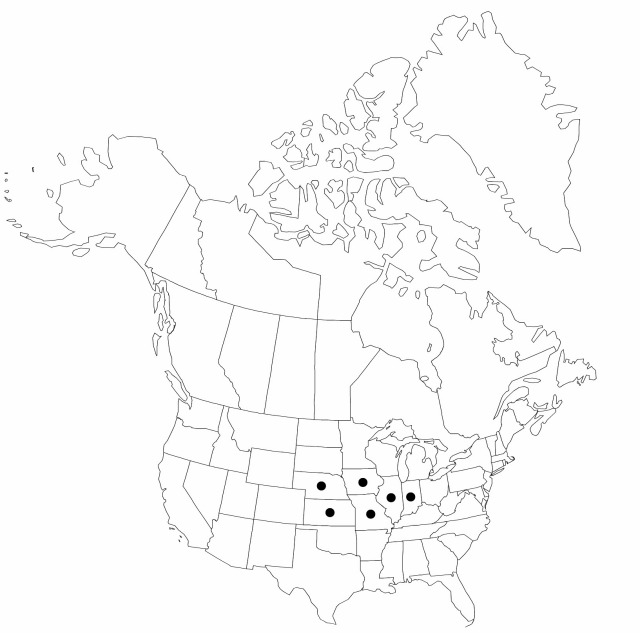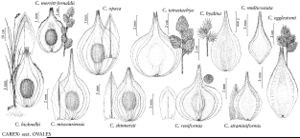Carex missouriensis
Novon 11: 220, figs. 1(left), 3C, 4, 10. 2001.
Plants densely cespitose, to 200 culms together; rhizomes may appear elongate in old clumps. Culms 45–90 cm; vegetative culms few, inconspiculous, usually fewer than 12 leaves, not strikingly 3-ranked. Leaves: sheaths glabrous, individually indistinct Y-shaped hyaline band reaching 0–8 mm below the collar, summit U-shaped or truncate, extending 0–2 mm beyond collar, smooth; distal ligules 2–4 mm; blades 3–6 per fertile culm, 2.5–25 cm × 1.8–3.2 (–4) mm. Inflorescences open to congested, erect to nodding, pale or golden brown, 2–4.5 cm × 7.5–19 mm; proximal internode 3.5–12 mm; 2d internode 3–10 mm; proximal bracts scalelike or often with bristle tips shorter than or equaling inflorescences. Spikes 3–8, distant, distinct, globose to ovoid or conic, 8–14 × 4.5–9.5 mm, base rounded to acute, apex acute, obtuse, or rounded. Pistillate scales pale yellowish-brown or occasionally copper-brown tinged, with narrow yellowbrown midstripe, lanceolate or lanceovate, 3.7–4.4 mm, reaching base to middle of perignyium beaks, margin whitish to brownish hyaline, apex membranaceous, curled, acuminate or awned to 0.7 mm. Staminate scales acuminate-awned. Anthers (1.8–) 2.2–3.6 mm. Perigynia 15–80 on larger spikes, loosely ascending, light green, yellowbrown, or copper-brown, green or brown winged, inconspicuously 0–3 (–5) -veined adaxially, 0–8-veined abaxially, 1–2 veins in winged margin, broadly elliptic to ovate, flat or concavo-convex except over achene, (4.2–) 4.6–6.7 (–7.1 in larger perigynia) × 2.5–4 mm, 0.5–0.7 mm thick, herbaceous, ± opaque, with achene not visible through adaxial face, margin flat, including wing 0.6–1.1 mm wide smooth; beak tip, strongly flattened, 2–2.8 mm, serrulate-margined to apex, abaxial suture pale or copper-brown, distance from beak tip to achene 2.6–4.2 mm. Achenes elliptic to ± orbiculate, 1.6–2.2 × 1.2–1.6 mm, 0.5–0.7 mm thick, apiculum to 0.4–1.1 mm. 2n =50, 52, 54.
Phenology: Fruiting early summer.
Habitat: Prairie swales
Elevation: 100–400 m
Distribution

Ill., Ind., Iowa, Kans., Mo., Nebr.
Discussion
Selected References
None.
Lower Taxa
"shortened" is not a number."+timesaslongasinflorescences" is not declared as a valid unit of measurement for this property."not undefined" is not a number.
